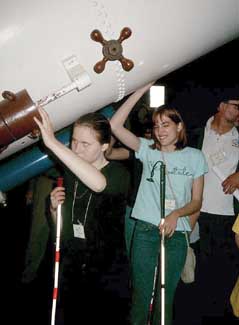Yerkes Observatory introduces blind students to universe
By Steve KoppesNews Office
 Grace King (left) and Chelsea Reilly of the Wisconsin Center for the Blind and Visually Impaired touch the 40-inch refracting telescope at Yerkes Observatory during a field trip this summer. Teacher Kelly Baily stands in the background. The Williams Bay, Wisc., Lions Club donated a Swellform Graphics Machine to the observatory that transforms images of the night sky into tactile form that can be studied by blind and visually impaired students. |
When Doyal Harper made his first observations with an airborne infrared telescope more than 30 years ago, he did not see anything.
Harper, Professor in Astronomy & Astrophysics, is blessed with good eyesight, but infrared light is, after all, invisible. So Harper used a device that converted light into sound to help him locate infrared light sources. The device squealed whenever his telescope found one, opening up a whole new world of astronomical observations to Harper and his fellow scientists.
Now the University’s Yerkes Observatory in Williams Bay, Wisc., and DePaul University’s Space Science Center for Education and Outreach are similarly opening the world of astronomy to blind students at the Wisconsin Center for the Blind and Visually Impaired through the Space Exploration Experience project. Project SEE “is creating astronomy discovery activities for visually impaired students,” said Vivian Hoette, Education Outreach Coordinator at Yerkes.
The collaboration includes the Wisconsin Center for the Blind and Visually Impaired in Janesville, the Colorado School for the Blind in Colorado Springs, and the Charles Hayden Planetarium of the Museum of Science in Boston. The project kicked off last June when seven of the Janesville students visited Yerkes for a tour and astronomy lessons prepared especially for them.
A key component of the project will be the $1,000 Swellform Graphics Machine that the Williams Bay Lions Club donated to Yerkes. The machine makes tactile images of astronomical phenomena, including sunspots, star clusters and diagrams of planetary orbits.
“These images will form the basis for lab and observing activities for blind and visually impaired students,” said DePaul astronomer Bernard Beck-Winchatz. The images permit students to measure the rotation rate of the sun, observe the lunar cycle, calculate the mass of Jupiter and more.
“At Yerkes we will actually connect the machine to one of the telescopes. The students will then be able to make their own observations, convert them into tactile format and analyze them using these tactile images,” Beck-Winchatz said.
During their visit to Yerkes in June, the Janesville students built their own infrared light detectors under Hoette’s supervision by connecting solar cells to an amplifier/speaker.
The students made the detectors buzz by pointing the infrared light beams of a television remote control at them.
The lesson was linked to Harper’s talk on airborne infrared astronomy and the Stratospheric Observatory for Infrared Astronomy, which is scheduled to begin flying next year. SOFIA will consist of a Boeing 747SP aircraft that has been modified to accommodate a 2.5-meter telescope in its fuselage. Harper is building the telescope’s high-resolution camera.
It is necessary to put an infrared telescope on an airplane because the Earth’s atmosphere prevents most infrared light from reaching the ground.
“The sort of astronomy that we’re doing here can’t be done from the ground,” Harper said.
![[Chronicle]](/images/sidebar_header_oct06.gif)